
Leucopogon obovatus is a species of flowering plant in the heath family Ericaceae and is endemic to the southwest of Western Australia. It is an erect shrub with hairy young branchlets, variably-shaped, simple leaves, and erect clusters of 3 to 15 white, bell-shaped flowers on the ends of branches and in upper leaf axils.

Leucopogon pendulus is a species of flowering plant in the heath family Ericaceae and is endemic to the south-west of Western Australia. It is an erect, straggling shrub with oblong leaves and white, tube-shaped flowers that are bearded inside.

Leucopogon tamminensis is a species of flowering plant in the heath family Ericaceae and is endemic to the southwest of Western Australia. It is a slender shrub with many branches, overlapping triangular to egg-shaped leaves and white, tube-shaped flower arranged singly in upper leaf axils.

Leucopogon alternifolius is a species of flowering plant in the heath family Ericaceae and is endemic to south of Western Australia. It is a low, sprawling shrub with thin branchlets, egg-shaped leaves with a heart-shaped, stem-clasping base, and white or pale pink flowers arranged in up to twenty groups along the flowering branchlets.

Leucopogon audax is a species of flowering plant in the heath family Ericaceae and is endemic to a restricted area of the south-west of Western Australia. It is an erect, open, single-stemmed shrub with hairy branchlets, egg-shaped leaves and white flowers sometimes tinged with pink, in groups in upper leaf axils or on the ends of branches.
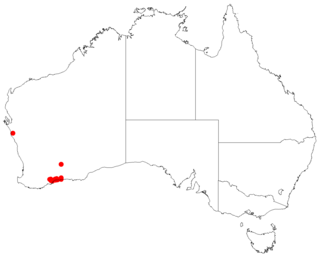
Leucopogon conchifolius is a species of flowering plant in the heath family Ericaceae and is endemic to the south-west of Western Australia. It is an erect shrublet with many branches, more or less round leaves near the ends of branchlets, and white, tube-shaped flowers arranged near the ends of leafy twigs.

Leucopogon cuneifolius is a species of flowering plant in the heath family Ericaceae and is endemic to Western Australia. It is an erect, bushy shrub that typically grows to a height of 0.2–1.5 m. Its leaves are egg-shaped to lance-shaped with the narrower end towards the base, about 6 mm (0.24 in) long with a distinct petiole. Up to 3 flowers are borne in upper leaf axils on a short peduncle, with small bracts and bracteoles at the base. The sepals are about 3 mm (0.12 in) long and the petals about 5 mm (0.20 in) long, the petal lobes much shorter than the petal tube.

Leucopogon denticulatus is a species of flowering plant in the heath family Ericaceae and is endemic to the south-west of Western Australia. It is an erect shrub with hairy young branchlets, overlapping egg-shaped leaves with small teeth on the edges and white, tube-shaped flowers.

Leucopogon fimbriatus is a species of flowering plant in the heath family Ericaceae and is endemic to the south-west of Western Australia. It is a bushy, erect or sprawling shrub with overlapping egg-shaped or oblong leaves and spikes of tube-shaped white flowers on the ends of branches.
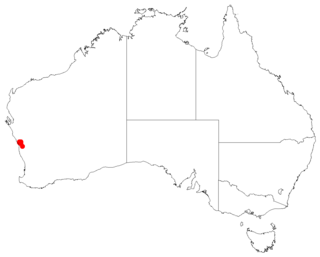
Leucopogon grammatus is a species of flowering plant in the heath family Ericaceae and is endemic to the south-west of Western Australia. It is an erect shrub with hairy young branchlets, spirally arranged, erect, egg-shaped leaves, and white, bell-shaped to broadly bell-shaped flowers.

Leucopogon inflexus is a species of flowering plant in the heath family Ericaceae and is endemic to the south-west of Western Australia. It is an erect, open shrub with more or less glabrous young branchlets, spirally arranged, erect, egg-shaped to more or less round leaves, and white, bell-shaped, densely bearded flowers.
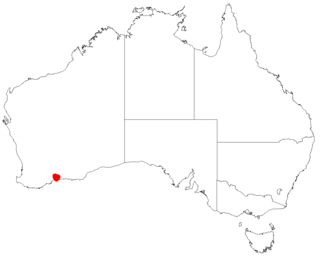
Leucopogon infuscatus is a species of flowering plant in the heath family Ericaceae and is endemic to the south-west of Western Australia. It is a shrublet with many branches, egg-shaped to lance-shaped leaves, and light brown, densely bearded flowers.
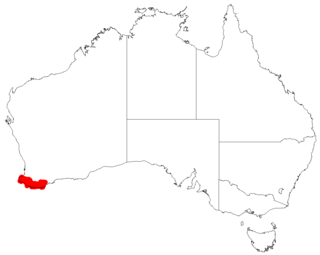
Leucopogon interstans is a species of flowering plant in the heath family Ericaceae and is endemic to the south-west of Western Australia. It is an erect shrub with brownish hairs on its young branchlets, erect, narrowly elliptic or narrowly egg-shaped leaves and white or pinkish flowers in groups in upper leaf axils or on the ends of branches.
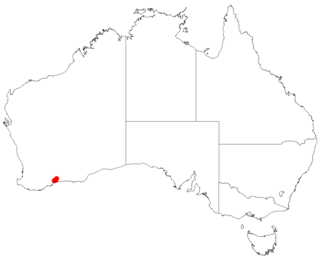
Leucopogon lloydiorum is a species of flowering plant in the heath family Ericaceae and is endemic to the south-west of Western Australia. It is a slender shrub with elliptic leaves clustered near the ends of branchlets, and white, densely-bearded, tube-shaped flowers.
Conostephium marchantiorum is a species of flowering plant in the heath family Ericaceae and is endemic to the south-west of Western Australia. It is an erect shrub with linear leaves clustered near the ends of branchlets, and pale green and pink, densely-bearded, tube-shaped flowers.
Leucopogon phyllostachys is a species of flowering plant in the heath family Ericaceae and is endemic to the south-west of Western Australia. It is an erect, glabrous shrub that typically grows to a height of 25–50 cm (9.8–19.7 in). Its leaves are mostly broadly heart-shaped to egg-shaped and more than 6 mm (0.24 in) long, sometimes egg-shaped and shorter, sometimes with a short, hard point on the tip. The flowers are arranged in cylindrical spikes on the ends of branches or in upper leaf axils. The bracteoles are less than half as long as the sepals that are about 2 mm (0.079 in) long, the petals about 4 mm (0.16 in) long, the petal lobes about the same length as the petal tube.

Leucopogon prolatus is a species of flowering plant in the heath family Ericaceae and is endemic to the south-west of Western Australia. It is an erect, open shrub with a single stem at ground level, egg-shaped to elliptic leaves and erect clusters of 3 to 14 white flowers on the ends of branches and short side-branches.

Leucopogon rotundifolius is a species of flowering plant in the heath family Ericaceae and is endemic to the south of Western Australia. It is an erect, bushy shrub with round or egg-shaped leaves, the narrower end towards the base, and white, tube-shaped flowers arranged in leaf axils in groups of 2 or 3.

Leucopogon spectabilis is a species of flowering plant in the heath family Ericaceae and is endemic to inland Western Australia. It is a narrow, erect shrub with few glabrous branchlets, narrowly elliptic leaves and relatively large white flowers arranged in 14 to 32 upper leaf axils.

Leucopogon tenuicaulis is a species of flowering plant in the heath family Ericaceae and is endemic to the far southwest of Western Australia. It is an erect or sprawling shrub with thin stems, upright triangular to narrowly egg-shaped or narrowly elliptic leaves and erect, white or pale pink, tube-shaped flower arranged in large groups on the ends of branches and in upper leaf axils.


















